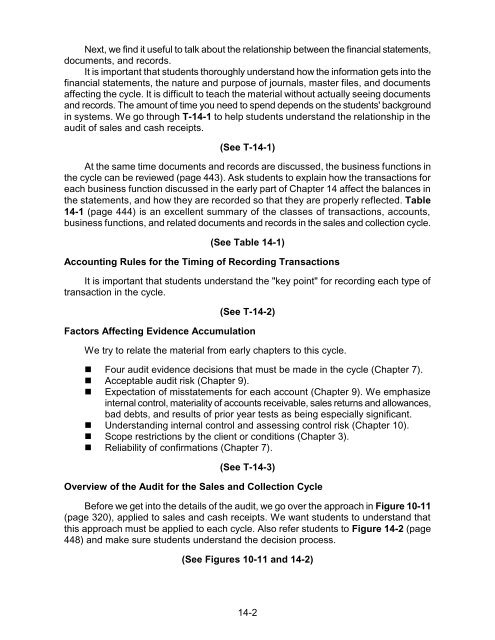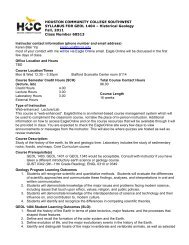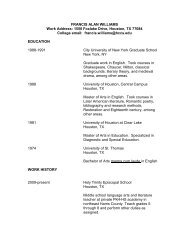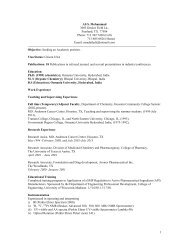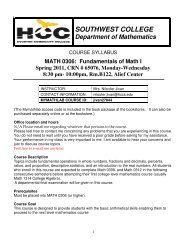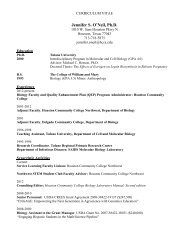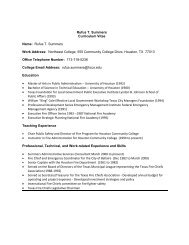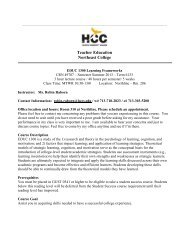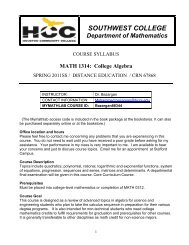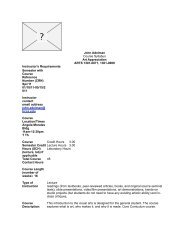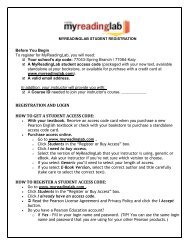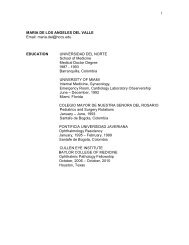Chapter 14 Audit of the Sales and Collection Cycle - HCC Learning ...
Chapter 14 Audit of the Sales and Collection Cycle - HCC Learning ...
Chapter 14 Audit of the Sales and Collection Cycle - HCC Learning ...
Create successful ePaper yourself
Turn your PDF publications into a flip-book with our unique Google optimized e-Paper software.
Next, we find it useful to talk about <strong>the</strong> relationship between <strong>the</strong> financial statements,documents, <strong>and</strong> records.It is important that students thoroughly underst<strong>and</strong> how <strong>the</strong> information gets into <strong>the</strong>financial statements, <strong>the</strong> nature <strong>and</strong> purpose <strong>of</strong> journals, master files, <strong>and</strong> documentsaffecting <strong>the</strong> cycle. It is difficult to teach <strong>the</strong> material without actually seeing documents<strong>and</strong> records. The amount <strong>of</strong> time you need to spend depends on <strong>the</strong> students' backgroundin systems. We go through T-<strong>14</strong>-1 to help students underst<strong>and</strong> <strong>the</strong> relationship in <strong>the</strong>audit <strong>of</strong> sales <strong>and</strong> cash receipts.(See T-<strong>14</strong>-1)At <strong>the</strong> same time documents <strong>and</strong> records are discussed, <strong>the</strong> business functions in<strong>the</strong> cycle can be reviewed (page 443). Ask students to explain how <strong>the</strong> transactions foreach business function discussed in <strong>the</strong> early part <strong>of</strong> <strong>Chapter</strong> <strong>14</strong> affect <strong>the</strong> balances in<strong>the</strong> statements, <strong>and</strong> how <strong>the</strong>y are recorded so that <strong>the</strong>y are properly reflected. Table<strong>14</strong>-1 (page 444) is an excellent summary <strong>of</strong> <strong>the</strong> classes <strong>of</strong> transactions, accounts,business functions, <strong>and</strong> related documents <strong>and</strong> records in <strong>the</strong> sales <strong>and</strong> collection cycle.(See Table <strong>14</strong>-1)Accounting Rules for <strong>the</strong> Timing <strong>of</strong> Recording TransactionsIt is important that students underst<strong>and</strong> <strong>the</strong> "key point" for recording each type <strong>of</strong>transaction in <strong>the</strong> cycle.(See T-<strong>14</strong>-2)Factors Affecting Evidence AccumulationWe try to relate <strong>the</strong> material from early chapters to this cycle.• Four audit evidence decisions that must be made in <strong>the</strong> cycle (<strong>Chapter</strong> 7).• Acceptable audit risk (<strong>Chapter</strong> 9).• Expectation <strong>of</strong> misstatements for each account (<strong>Chapter</strong> 9). We emphasizeinternal control, materiality <strong>of</strong> accounts receivable, sales returns <strong>and</strong> allowances,bad debts, <strong>and</strong> results <strong>of</strong> prior year tests as being especially significant.• Underst<strong>and</strong>ing internal control <strong>and</strong> assessing control risk (<strong>Chapter</strong> 10).• Scope restrictions by <strong>the</strong> client or conditions (<strong>Chapter</strong> 3).• Reliability <strong>of</strong> confirmations (<strong>Chapter</strong> 7).(See T-<strong>14</strong>-3)Overview <strong>of</strong> <strong>the</strong> <strong>Audit</strong> for <strong>the</strong> <strong>Sales</strong> <strong>and</strong> <strong>Collection</strong> <strong>Cycle</strong>Before we get into <strong>the</strong> details <strong>of</strong> <strong>the</strong> audit, we go over <strong>the</strong> approach in Figure 10-11(page 320), applied to sales <strong>and</strong> cash receipts. We want students to underst<strong>and</strong> thatthis approach must be applied to each cycle. Also refer students to Figure <strong>14</strong>-2 (page448) <strong>and</strong> make sure students underst<strong>and</strong> <strong>the</strong> decision process.(See Figures 10-11 <strong>and</strong> <strong>14</strong>-2)<strong>14</strong>-2


